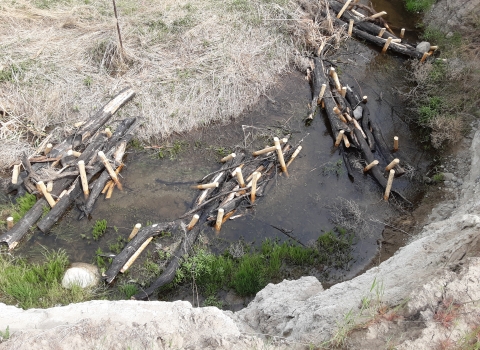If you enjoy a steaming cup of coffee first thing in the morning; a creamy bite of chocolate for dessert; a juicy, ripe watermelon in the summertime; or any number of fresh fruits, veggies, or flowers, thank a bumble bee.
This is one of the busiest and most important species. Every other species – animal, plant, and human – benefits from the work of these creatures. These little pollinators contribute to the larger ecosystem in huge ways.
“Bumble bees are incredibly valuable pollinators of both flowering plants and agricultural crops. Without bumble bees, our grocery stores and landscapes would look very different,” said Gabriela Garrison, Eastern Piedmont Habitat conservation coordinator for the North Carolina Wildlife Resources Commission. “It would also have lasting repercussions across many taxa of wildlife that rely on seeds and fruits from flowering plants.”
Bumble bees buzz from flower to flower, taking in nectar or pollen, eating the nectar and spreading the pollen from spot to spot. In this way, while gathering their own food, they help fertilize the plants that produce the seeds that help provide food for the rest of us.
Garrison explains that, in general, bees help produce at least a third of humans’ food supply. In addition, they pollinate more than 85 percent of wild-flowering plants. Bumble bees are great generalists when it comes to the pollination business as they visit many different species of plants. And they work diverse climates, whether in perfect weather or in cooler, less ideal conditions. Their diversity is as varied as the biodiversity found across the Southeast.
To make it in the wild, and to help produce some of the yummy fruits and veggies humans enjoy, bees need very few essentials. With plentiful food and safe shelter, they are set. Unfortunately, the bees’ real world isn’t as simple as that.
Throughout the region, invasive plants take over the landscape, reducing food and shelter for bumble bees. Additional threats, including climate change climate change
Climate change includes both global warming driven by human-induced emissions of greenhouse gases and the resulting large-scale shifts in weather patterns. Though there have been previous periods of climatic change, since the mid-20th century humans have had an unprecedented impact on Earth's climate system and caused change on a global scale.
Learn more about climate change , pesticides, habitat fragmentation, and disease, are killing off the bees keeping us alive.
Of the 4,000 species of bees in the United States, eight are federally listed as endangered, including the rusty patched bumble bee. Listed as endangered in 2017, this once prolific species is now found in only 10 states, none in the Southeast. Scientists haven’t seen a rusty patched in this region in more than two decades. But the southeast is rather large, spanning 10 states, so there may be hope for the rusty patched and other bumble bee species.
The U.S. Fish and Wildlife Service teamed up with the North Carolina Wildlife Resource Commission (NCWRC) , the Xerces Society and several other states and organizations on the Southeast Bumble Bee Atlas project. The effort enrolls volunteers who help biologists study and gather data on the habitat, population, and lifecycle of bumble bees in this region.
“Learning more about their presence on the landscape, as well as their foraging preferences, will help us make better management decisions to positively influence conservation efforts,” said Garrison. “We hope to sustain and preferably increase bumble bee populations across the region. We also hope to learn more about the factors that are causing such precipitous population declines.”
Anyone can help with this region-wide science project, including private citizens, schools, civic and community-based organizations, really anyone. Minimal equipment is necessary. The main requirement is a commitment to learning more about this important species and taking part of the atlas effort, helping ensure it survives and thrives.
“Every community scientist can make a difference, and we need their help. Without their time, dedication, and commitment, we wouldn’t be able to gather this crucial information and bumble bee populations would more than likely continue to decline,” Garrison said. “Collaboration is key.”
To contribute to the effort, citizens choose where they want to observe bumble bees. Then, after capturing a bumble bee, they take pictures, record data, and load it into a database, marrying their findings with those from other citizen-scientists.
Biologists who study bumble bees for a living take it from there. Scientists identify the bumble bee species, analyze the data to determine how best to help the bumble bee population and give a boost to its habitat.
“This broad-scale approach benefits our pollinator conservation efforts,” said Bryan Tompkins, a Service biologist in Asheville, North Carolina, who coordinates pollinator conservation efforts in the Southeast and who helped spearhead the atlas partnership. “We can’t achieve the Service’s conservation and preservation goals without committed partners and engaged citizens.”
The Service’s contributions, which include a $100,000 grant to the Southeast Bumble Bee Atlas, complements those of the Endangered Species Act, which celebrates its 50th anniversary this year. The Act provides a critical safety net for fish, wildlife, plants – and bumble bees. It has prevented the extinction of hundreds of imperiled species, promoted the recovery of many others, and conserved the habitats upon which they depend.
Each of these species is a part of the web of life. Each has a unique cultural and biological community. And each performs services that are essential to the greater ecosystem’s well-being. By taking part in the Southeast Bumble Bee Atlas, citizens help conserve bumble bees and all the yummy and beautiful benefits they afford.




